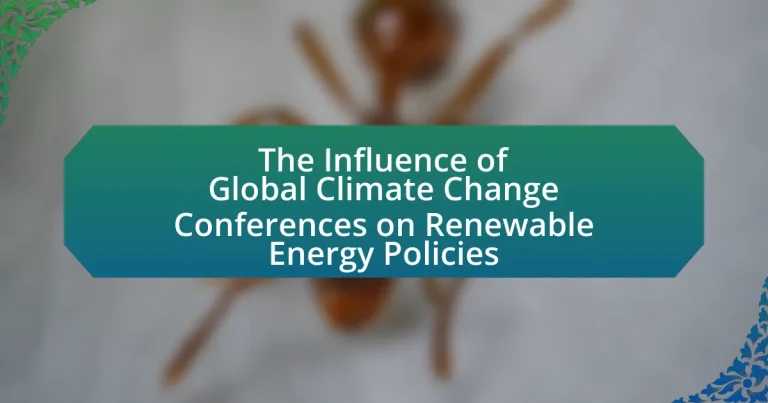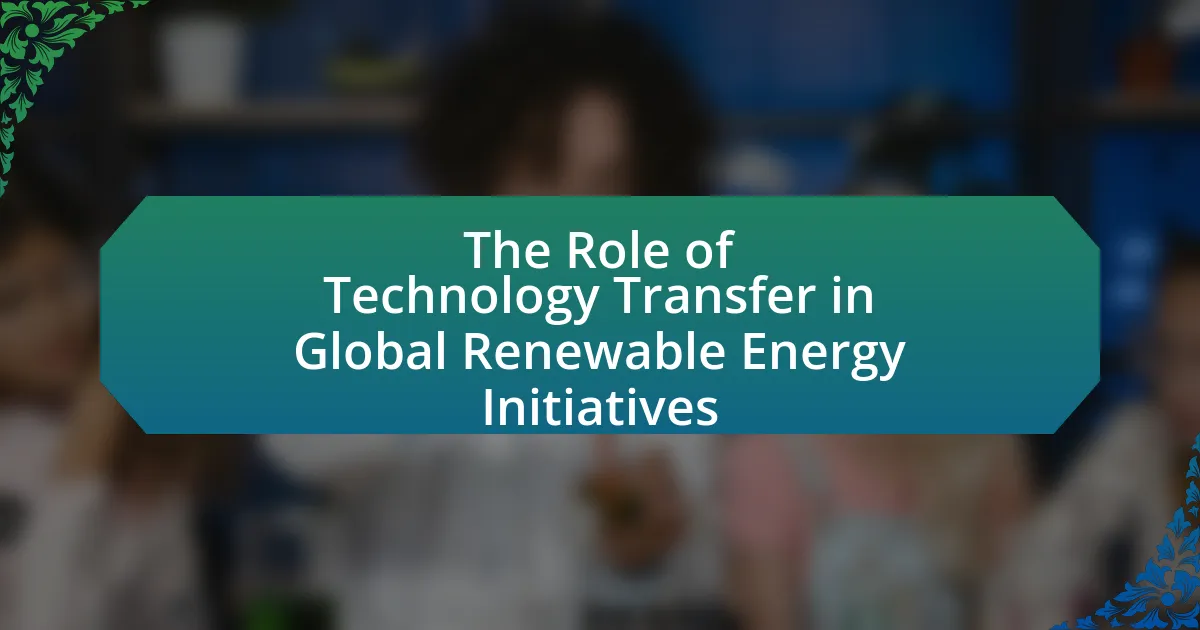Global climate change conferences play a pivotal role in shaping renewable energy policies by fostering international cooperation and establishing binding emissions reduction targets. Key agreements, such as the Paris Agreement, compel countries to commit to specific renewable energy goals, leading to increased investments in clean technologies and significant growth in global renewable energy capacity. These conferences not only influence national legislation and investment strategies but also facilitate collaboration among nations, promoting shared best practices and funding mechanisms. However, challenges such as differing national interests and political barriers can hinder the effective implementation of these policies. Overall, the outcomes of these conferences are crucial for driving the global transition towards sustainable energy solutions.
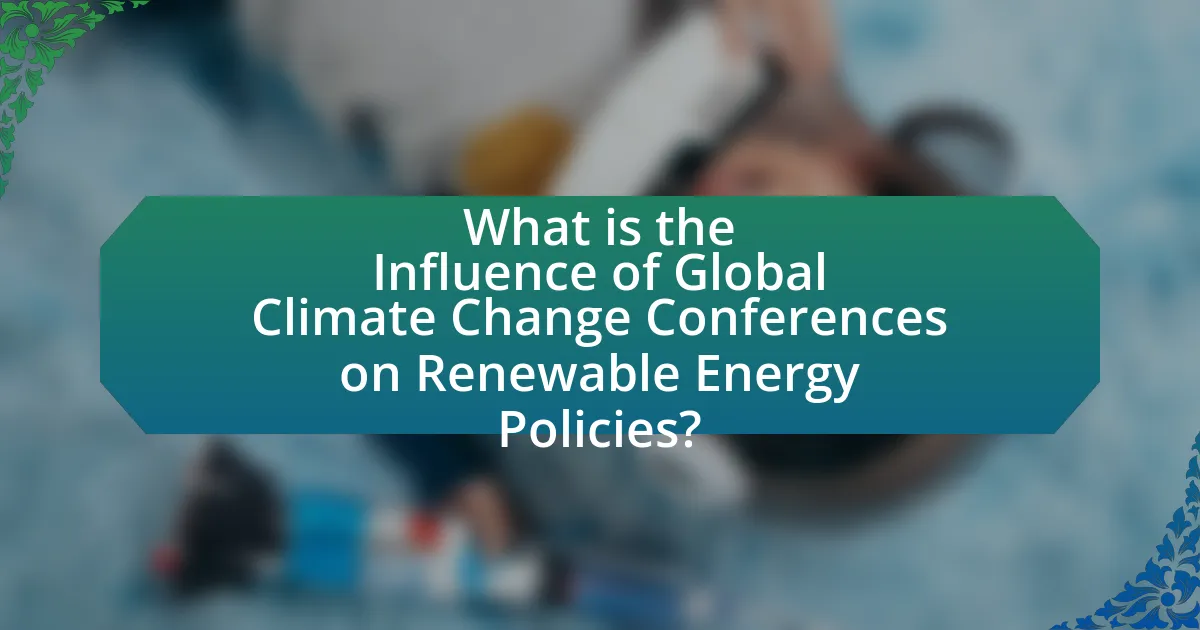
What is the Influence of Global Climate Change Conferences on Renewable Energy Policies?
Global climate change conferences significantly influence renewable energy policies by fostering international cooperation and setting binding targets for emissions reductions. These conferences, such as the Paris Agreement in 2015, compel countries to commit to specific renewable energy goals, thereby driving national policies towards cleaner energy sources. For instance, after the Paris Agreement, many nations increased their investments in renewable technologies, with global renewable energy capacity growing by 10.3% in 2019 alone, according to the International Renewable Energy Agency. This trend illustrates how the commitments made at these conferences translate into actionable policies that promote the adoption of renewable energy solutions worldwide.
How do global climate change conferences shape renewable energy policies?
Global climate change conferences shape renewable energy policies by establishing international agreements that set targets for emissions reductions and promote the adoption of clean energy technologies. For instance, the Paris Agreement, adopted in 2015, commits countries to limit global warming to well below 2 degrees Celsius, which incentivizes nations to transition to renewable energy sources. These conferences facilitate collaboration among countries, leading to shared best practices and funding mechanisms, such as the Green Climate Fund, which supports developing nations in implementing renewable energy projects. Additionally, the outcomes of these conferences influence national legislation and investment strategies, as countries align their policies with international commitments to combat climate change.
What key agreements have emerged from these conferences?
Key agreements that have emerged from global climate change conferences include the Paris Agreement, which established a framework for countries to limit global warming to well below 2 degrees Celsius, and the commitment to achieve net-zero emissions by mid-century. Additionally, the Glasgow Climate Pact emphasized the need for increased climate finance and the phasing out of unabated coal power. These agreements are supported by commitments from nearly 200 countries, reflecting a collective effort to transition towards renewable energy and reduce greenhouse gas emissions.
How do these agreements impact national renewable energy strategies?
International climate agreements significantly shape national renewable energy strategies by establishing binding targets and frameworks for emissions reductions. These agreements, such as the Paris Agreement, compel countries to commit to specific renewable energy goals, thereby incentivizing investments in clean technologies. For instance, nations that ratified the Paris Agreement are required to submit nationally determined contributions (NDCs) that outline their plans for reducing greenhouse gas emissions, often leading to increased focus on renewable energy sources like wind, solar, and hydroelectric power. This shift is supported by data indicating that countries with clear renewable energy commitments have seen substantial growth in their renewable energy sectors, with global renewable energy capacity increasing by 10.3% in 2020, according to the International Renewable Energy Agency (IRENA). Thus, these agreements not only influence policy direction but also drive technological advancements and financial investments in renewable energy.
Why are global climate change conferences significant for renewable energy?
Global climate change conferences are significant for renewable energy because they facilitate international agreements and commitments that drive investment and policy changes in the renewable sector. These conferences, such as the annual COP meetings, bring together world leaders, policymakers, and stakeholders to negotiate frameworks like the Paris Agreement, which aims to limit global warming and promote sustainable energy solutions. For instance, the Paris Agreement, adopted in 2015, set a target to limit temperature rise to well below 2 degrees Celsius, encouraging countries to transition to renewable energy sources. This collective action leads to increased funding for renewable technologies, shared best practices, and the establishment of regulatory frameworks that support the growth of renewable energy markets globally.
What role do these conferences play in international cooperation?
Global climate change conferences play a crucial role in fostering international cooperation by providing a platform for countries to negotiate agreements, share best practices, and commit to collective action against climate change. These conferences, such as the annual Conference of the Parties (COP), facilitate dialogue among nations, enabling them to establish legally binding targets and frameworks, like the Paris Agreement, which aims to limit global warming to well below 2 degrees Celsius. The participation of nearly 200 countries in these conferences demonstrates their significance in uniting diverse stakeholders around common environmental goals, thereby enhancing collaborative efforts in renewable energy policies and climate resilience initiatives.
How do they influence public and private sector investment in renewable energy?
Global climate change conferences influence public and private sector investment in renewable energy by establishing international commitments and frameworks that encourage investment. These conferences, such as the Paris Agreement, create binding targets for greenhouse gas emissions reduction, prompting governments to allocate funds and resources towards renewable energy projects. For instance, the commitment made by countries to limit global warming to below 2 degrees Celsius has led to increased funding for solar and wind energy initiatives, as evidenced by a report from the International Renewable Energy Agency, which noted a 20% increase in global renewable energy investment following the Paris Agreement. Additionally, these conferences foster collaboration between nations and private entities, leading to innovative financing mechanisms and partnerships that further stimulate investment in renewable energy technologies.
What challenges do global climate change conferences face in influencing renewable energy policies?
Global climate change conferences face significant challenges in influencing renewable energy policies, primarily due to differing national interests and economic priorities. Countries often prioritize short-term economic growth over long-term environmental goals, leading to resistance against adopting renewable energy initiatives. For instance, fossil fuel-dependent nations may oppose stringent regulations that threaten their economic stability, as seen in the negotiations during the Paris Agreement, where major oil-producing countries sought to protect their interests. Additionally, the lack of binding commitments and enforcement mechanisms in international agreements often results in insufficient action on renewable energy policies, as countries may fail to meet their voluntary targets. This combination of conflicting interests and weak accountability undermines the effectiveness of global climate change conferences in driving substantial policy changes in renewable energy.
What are the political barriers to implementing agreed-upon policies?
Political barriers to implementing agreed-upon policies include lack of political will, conflicting interests among stakeholders, and inadequate funding. Political will is often undermined by short-term electoral cycles, where politicians prioritize immediate concerns over long-term policy commitments. Conflicting interests arise when different political factions or interest groups have divergent priorities, leading to gridlock in decision-making. Additionally, inadequate funding can hinder the execution of policies, as governments may lack the necessary resources or face budget constraints that limit their ability to invest in renewable energy initiatives. For instance, during the 2015 Paris Agreement negotiations, many countries expressed commitment but struggled to align their national policies with the financial and structural support needed for implementation.
How do economic factors affect the outcomes of these conferences?
Economic factors significantly influence the outcomes of global climate change conferences by shaping the priorities and commitments of participating nations. For instance, countries with stronger economies are often able to invest more in renewable energy technologies and infrastructure, leading to more ambitious climate pledges. Conversely, nations facing economic challenges may prioritize immediate economic growth over long-term sustainability goals, resulting in weaker commitments.
Evidence of this can be seen in the 2015 Paris Agreement, where wealthier nations committed to more substantial emissions reductions and financial support for developing countries, reflecting their economic capacity. Additionally, the Global Climate Finance report indicates that financial flows to developing countries for climate-related projects reached $79.6 billion in 2019, demonstrating how economic resources directly impact the ability of nations to engage effectively in climate initiatives.
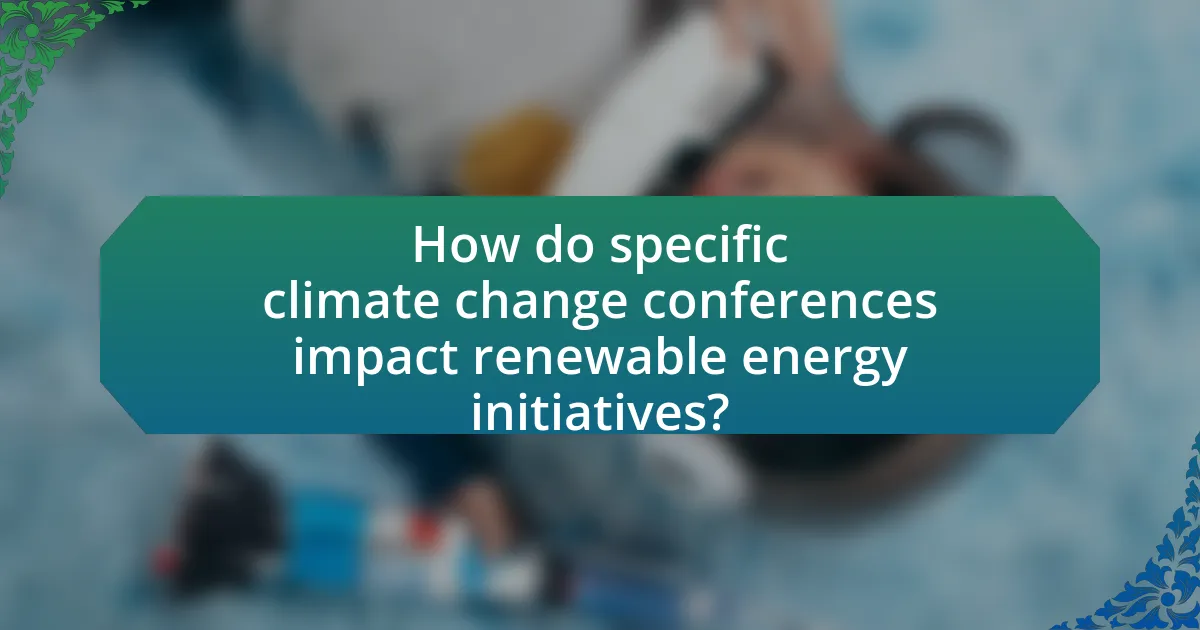
How do specific climate change conferences impact renewable energy initiatives?
Specific climate change conferences significantly influence renewable energy initiatives by establishing international commitments and frameworks that promote investment and policy alignment. For instance, the Paris Agreement, adopted during the 2015 COP21 conference, set a global target to limit temperature rise, which has led countries to enhance their renewable energy goals. As a result, nations have increased funding for renewable technologies, with global investment in renewable energy reaching approximately $300 billion in 2020, driven by commitments made at these conferences. Furthermore, these conferences facilitate collaboration among countries, enabling the sharing of best practices and technologies, which accelerates the deployment of renewable energy solutions worldwide.
What were the outcomes of the Paris Agreement on renewable energy policies?
The outcomes of the Paris Agreement on renewable energy policies include a significant increase in global commitments to transition towards renewable energy sources. Following the agreement, countries pledged to enhance their Nationally Determined Contributions (NDCs), which often included specific targets for renewable energy adoption. For instance, the International Renewable Energy Agency reported that global renewable energy capacity grew by 10.3% in 2019, largely influenced by the commitments made under the Paris Agreement. Additionally, investments in renewable energy technologies surged, with global investment reaching $282.2 billion in 2019, reflecting a shift in policy frameworks towards supporting clean energy initiatives. These outcomes demonstrate the Paris Agreement’s role in catalyzing a global movement towards sustainable energy solutions.
How did the commitments made in Paris influence national legislation?
The commitments made in Paris significantly influenced national legislation by prompting countries to adopt legally binding climate targets and integrate them into their domestic laws. For instance, many nations revised their energy policies to align with the Paris Agreement’s goal of limiting global warming to well below 2 degrees Celsius, leading to the establishment of renewable energy mandates and emissions reduction frameworks. Countries like the United Kingdom enacted the Climate Change Act, which set legally binding carbon budgets, while others, such as France, introduced laws to phase out fossil fuels and promote renewable energy sources. These legislative changes reflect a direct response to the commitments made in Paris, demonstrating a shift towards sustainable energy policies on a national level.
What mechanisms were established to monitor progress in renewable energy adoption?
Governments and international organizations established various mechanisms to monitor progress in renewable energy adoption, including reporting frameworks, performance indicators, and verification processes. For instance, the United Nations Framework Convention on Climate Change (UNFCCC) requires countries to submit Nationally Determined Contributions (NDCs) that outline their renewable energy targets and progress. Additionally, the International Renewable Energy Agency (IRENA) provides data collection and analysis tools, such as the Renewable Energy Capacity Statistics, which track global renewable energy capacity and trends. These mechanisms ensure transparency and accountability in the transition to renewable energy sources.
How have recent conferences shifted the focus towards renewable energy?
Recent conferences have shifted the focus towards renewable energy by prioritizing commitments to reduce carbon emissions and promoting sustainable energy solutions. For instance, the 2021 United Nations Climate Change Conference (COP26) emphasized the need for countries to transition to renewable energy sources, with over 130 nations pledging to phase out coal and invest in clean energy technologies. This shift is further evidenced by the increased participation of private sector stakeholders, who are now more actively involved in discussions about renewable energy investments and innovations. Additionally, the conference outcomes have led to the establishment of initiatives like the Global Methane Pledge, which aims to reduce methane emissions and encourages the adoption of renewable energy alternatives.
What new targets have been set for renewable energy adoption?
New targets for renewable energy adoption include a commitment to achieve 50% of global energy consumption from renewable sources by 2030, as outlined in the latest climate agreements from the 2023 United Nations Climate Change Conference. This target reflects an increase from previous goals, emphasizing the urgency to transition away from fossil fuels. The International Energy Agency supports this target, stating that achieving it could significantly reduce greenhouse gas emissions and limit global warming to 1.5 degrees Celsius.
How do these targets compare to previous commitments?
The current targets for renewable energy policies are generally more ambitious than previous commitments made during earlier climate change conferences. For instance, the Paris Agreement established a goal to limit global warming to well below 2 degrees Celsius, with many countries committing to specific renewable energy targets by 2030. In contrast, earlier commitments, such as those made during the Kyoto Protocol, focused primarily on emissions reductions without explicit renewable energy benchmarks. This shift reflects a growing recognition of the need for a transition to renewable energy sources, as evidenced by the increased number of countries pledging to achieve net-zero emissions by mid-century, a commitment that was less prevalent in earlier agreements.
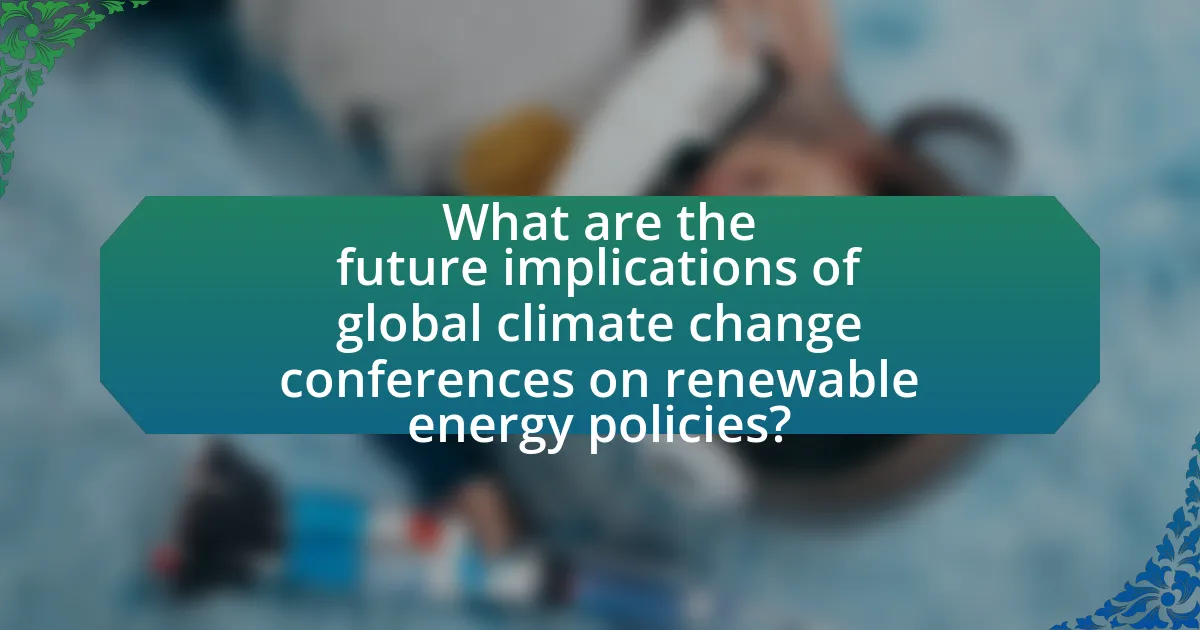
What are the future implications of global climate change conferences on renewable energy policies?
Global climate change conferences will significantly influence renewable energy policies by fostering international cooperation and setting binding targets for emissions reductions. These conferences, such as the Paris Agreement, have already led to commitments from countries to transition towards renewable energy sources, aiming for net-zero emissions by mid-century. For instance, the International Energy Agency reported that global renewable energy capacity grew by 45% in 2020, driven by policy frameworks established during these conferences. As nations align their policies with international agreements, investments in renewable technologies are expected to increase, leading to enhanced innovation and cost reductions in solar, wind, and other renewable sectors.
How might upcoming conferences influence future renewable energy trends?
Upcoming conferences can significantly influence future renewable energy trends by facilitating collaboration, sharing innovative technologies, and shaping policy frameworks. These events often bring together industry leaders, policymakers, and researchers, creating a platform for discussing advancements and challenges in renewable energy. For instance, the annual United Nations Climate Change Conference (COP) has historically led to commitments that drive investment in renewable technologies, as seen with the Paris Agreement in 2015, which aimed to limit global warming and encouraged countries to enhance their renewable energy capacities. Additionally, conferences often highlight successful case studies and best practices, which can inspire other nations to adopt similar strategies, thereby accelerating the global transition to renewable energy sources.
What emerging technologies are likely to be prioritized in future discussions?
Emerging technologies likely to be prioritized in future discussions include advanced energy storage systems, carbon capture and storage (CCS), and hydrogen fuel technologies. These technologies are critical for enhancing renewable energy integration and reducing greenhouse gas emissions. For instance, advanced energy storage systems, such as lithium-ion and solid-state batteries, are essential for managing the intermittent nature of renewable sources like solar and wind. According to the International Energy Agency, energy storage capacity is projected to grow significantly, reaching 1,200 gigawatts by 2040, which underscores its importance in future energy policies. Carbon capture and storage technologies are also gaining attention, as they can potentially reduce emissions from fossil fuel power plants by up to 90%. Furthermore, hydrogen fuel technologies are being explored as a clean energy carrier, with the hydrogen market expected to reach $183 billion by 2023, highlighting its potential role in decarbonizing various sectors.
How can countries prepare for changes in renewable energy policies post-conference?
Countries can prepare for changes in renewable energy policies post-conference by conducting comprehensive assessments of their current energy frameworks and aligning them with anticipated international commitments. This involves analyzing the outcomes of the conference, such as new targets for emissions reductions or renewable energy adoption, and integrating these into national strategies. For instance, after the Paris Agreement in 2015, many countries revised their Nationally Determined Contributions (NDCs) to reflect more ambitious climate goals, demonstrating a proactive approach to policy adaptation. Additionally, countries can engage stakeholders, including industry leaders and civil society, to foster collaboration and ensure that policies are practical and widely supported. This collaborative approach has been shown to enhance the effectiveness of policy implementation, as seen in Germany’s Energiewende initiative, which successfully transitioned the country towards renewable energy through stakeholder engagement and clear policy frameworks.
What best practices can be adopted from past climate change conferences to enhance renewable energy policies?
Best practices that can be adopted from past climate change conferences to enhance renewable energy policies include establishing clear, binding commitments for emissions reductions, promoting international cooperation through technology transfer, and integrating stakeholder engagement in policy formulation. For instance, the Paris Agreement, established in 2015, set a framework for countries to commit to specific emissions targets, which has encouraged nations to adopt more ambitious renewable energy policies. Additionally, conferences have highlighted the importance of financial mechanisms, such as the Green Climate Fund, which supports developing countries in transitioning to renewable energy. These practices demonstrate that structured commitments, collaborative efforts, and inclusive processes are essential for effective renewable energy policy enhancement.
How can stakeholders effectively engage in the conference process?
Stakeholders can effectively engage in the conference process by actively participating in discussions, providing expert insights, and collaborating on policy development. Engaging stakeholders, such as government representatives, NGOs, and industry leaders, fosters a comprehensive dialogue that can lead to actionable outcomes. For instance, the Paris Agreement in 2015 showcased how diverse stakeholder involvement can shape international climate commitments, demonstrating that inclusive participation enhances the legitimacy and effectiveness of the conference outcomes.
What lessons have been learned that can guide future policy development?
Lessons learned from global climate change conferences indicate that collaborative international frameworks are essential for effective renewable energy policy development. These conferences, such as the Paris Agreement, have demonstrated that binding commitments and transparent reporting mechanisms foster accountability among nations, leading to more ambitious climate goals. Additionally, the integration of scientific research into policy-making has proven crucial; for instance, the Intergovernmental Panel on Climate Change (IPCC) reports provide critical data that inform policy decisions. Furthermore, stakeholder engagement, including input from local communities and private sectors, has shown to enhance the relevance and acceptance of renewable energy initiatives. These lessons underscore the importance of cooperation, evidence-based strategies, and inclusive dialogue in shaping future policies that effectively address climate change and promote renewable energy adoption.
